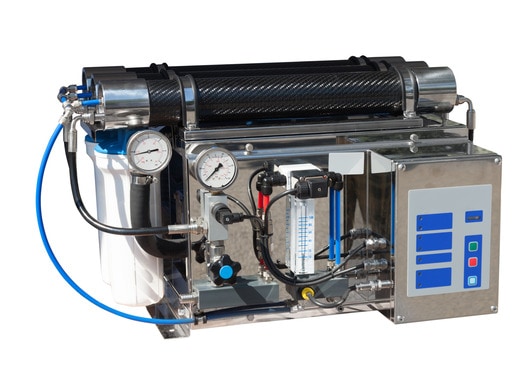
Originally used to remove salt from sea water, reverse osmosis is now widely applied in residential and commercial settings to purify tap water. A typical reverse osmosis system consists of a reverse osmosis unit with a semi-permeable membrane, a series of filters before and after the unit, a storage tank and a drain. As the water passes through the reverse osmosis unit and various additional filters, the impurities get caught by the membrane and the rest of the water is forced through by the pressure. The impurities are then discarded through the drain and you get clean drinking water from your tap.
Reverse osmosis is effective in removing 99% of common water contaminants, such as total dissolved solids, heavy metals, naturally occurring chemicals that are out of balance and other impurities. Additional pre- and post-osmosis filters can be installed to catch sediment, remove chlorine, get rid of unpleasant tastes, odors and bacterial contaminants.
With Reverse Osmosis You Get:
- clean drinking water from your tap
- ice cubes that are safe to add to your drinks
- better-tasting water that improves the beverages and meals it’s used for
Depending on your needs and budget, you can install a reverse osmosis system for the entire house (a point-of-entry system) or one that services a single faucet in your home (a point-of-use-system). However, a whole-house reverse osmosis system might be impractical because for every gallon of purified water, two to three gallons of waste water are typically discarded. This will increase your household water consumption and might put extra pressure on your well and well pump. Different reverse osmosis units may differ in efficiency, so check with your Maryland water purification expert to determine which model best meets your needs.
Durability & Low Maintenance
Most modern reverse osmosis systems are extremely reliable and will last you a long time with proper installation and maintenance. The only servicing they require is biannual filter change and membrane replacement every four to five years.
The frequency of maintenance will depend on several factors:
- How well the water is treated before it passes through the osmosis unit
- How frequently the system is being engaged
- At what rate the impurities are being discarded
- The quality of individual system components
A reverse osmosis system is an initial investment that will save you money in the long run. Think of not having to rely on bottled water for drinking or cooking—that’s also a lot of room in the recycling, especially if you buy gallons.
Feel free to contact R & G Water Systems if you have questions about reverse osmosis or would like us to install your unit—our experts are always here to help!
